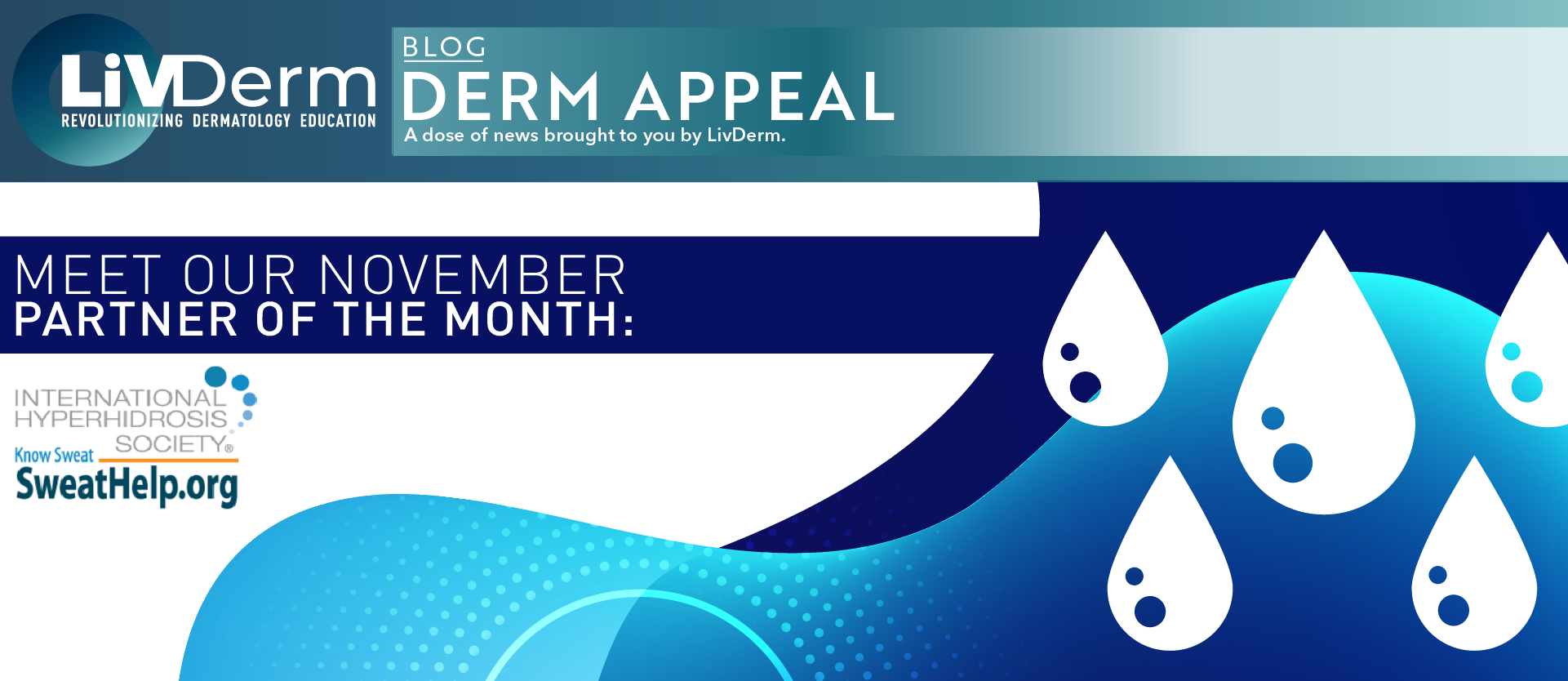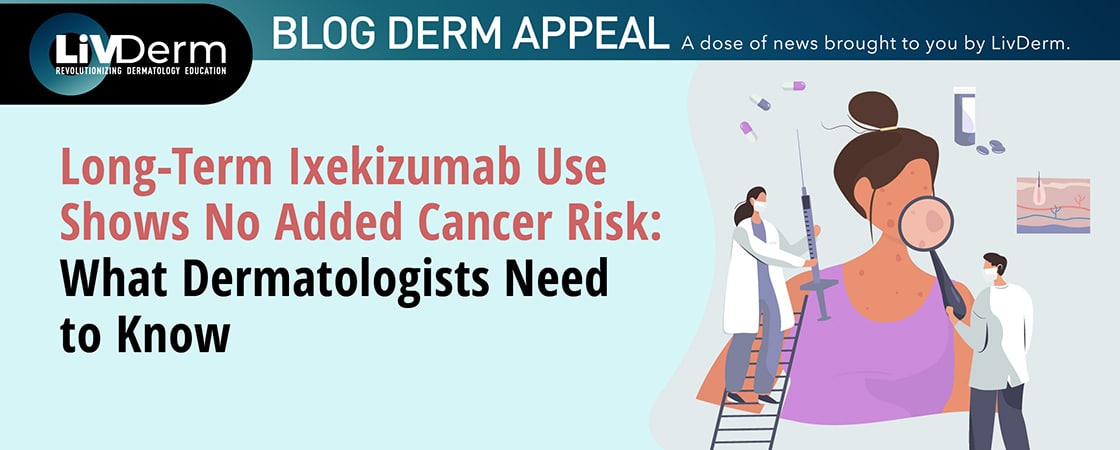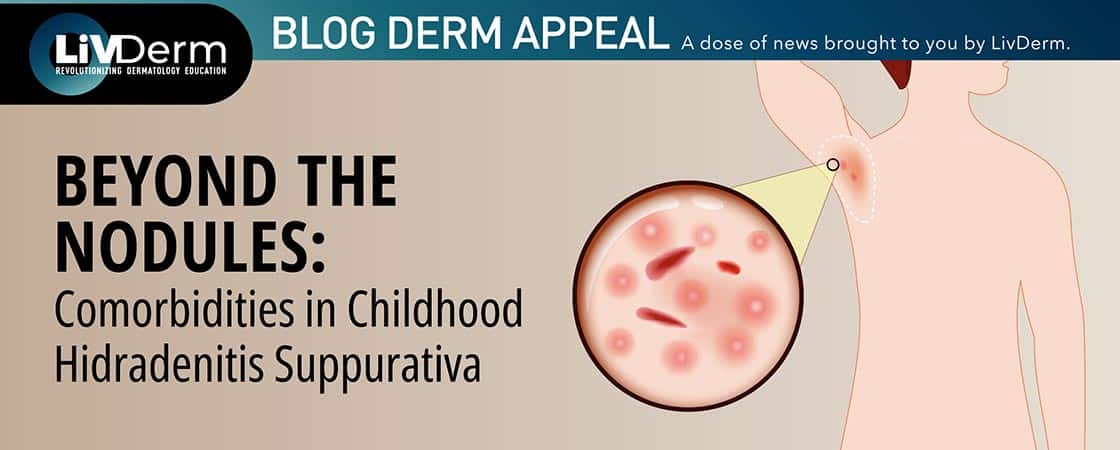Widespread Medical Condition You May Overlook – But Shouldn’t
From Physical to Mental Health, This Skin Condition Impacts 365 MILLION People Worldwide But Remains Underserved:
November Awareness Month Works to Change That
By: Angela Ballard, RN, International Hyperhidrosis Society
There is a dermatologic condition that impacts nearly 5% of the general population and nearly 9% of people aged 18-39 years. 1 The disorder tends to “run” in families 2 and is associated with higher rates of depression, anxiety3 and attention deficit disorder. 4,5 It also makes skin infections three times as likely.6 More common than autism,7 melanoma 8, psoriasis 9 and peanut allergies,10 the condition remains undertreated with just 1 in 4 sufferers ever diagnosed1 and even fewer cared for with up-to-date best practices.
What is it?
Hyperhidrosis, or excessive sweating, and despite its widespread prevalence and significant impacts on general and mental health, it’s still too often misunderstood and underserved – even by dermatologists.
This November, you can help change that by getting involved in Hyperhidrosis Awareness Month.
Throughout the month, the International Hyperhidrosis Society will be providing clinicians, hyperhidrosis sufferers and the general public with educational and practical information to help improve understanding and management of extreme, uncontrollable sweating. Hyperhidrosis Awareness Month initiatives will also serve to inspire and motivate healthcare providers and patients to connect and build a community through social media, podcasts, poetry, and more.
Watch the International Hyperhidrosis Society on its channels all November (and all year) for information about hyperhidrosis diagnosis and treatment, and ways to get involved:
• Facebook @SweatingStopsHere
• Twitter @WeKnowSweat
• Instagram @WeKnowSweat
• YouTube
• Wherever you enjoy podcasts, and
• SweatHelp.org
The month’s highlights will include:
• Practical tips to help deal with inevitable stress sweat and body odor.
• Re-launch of the Hyperhidrosis Clinician Finder featuring improvements to the healthcare provider database that make it easier for excessive sweating sufferers to find licensed, up-to-date hyperhidrosis medical care (from providers like you!) To register your practice click here.
• Ways to help patients save money on prescription and over-the-counter health expenses (whether they are for hyperhidrosis or another condition.)
• A new episode of the Know Sweat Podcasts bringing listeners inspiration, support and an intimate look at the hyperhidrosis reality through the poetry of haiku.
While Hyperhidrosis is a serious sweating disorder that can lead to a wide range of negative impacts, there is hope. Treatment options have improved and expanded in recent years, best practices are more clearly understood, and, by working with a knowledgeable healthcare provider, most sufferers can find significant relief. It starts with awareness-building and seeking help, like what’s available via the International Hyperhidrosis Society during Hyperhidrosis Awareness Month and throughout the year.
The International Hyperhidrosis Society acknowledges the generosity of individual donors and Dermira Inc. (a wholly-owned subsidiary of Eli Lilly) whose support has helped make 2020 Hyperhidrosis Awareness Month initiatives possible.
More About the International Hyperhidrosis Society
The International Hyperhidrosis Society (IHhS) was founded in 2003 by a team of dedicated advocates working alongside physicians respected worldwide for achievements in hyperhidrosis research and treatment. Today, IHhS remains the only independent, non-profit, global organization striving to improve quality of life among those affected by excessive sweating (as well as helping those with other sweat disorders.) IHhS’ mission focuses on reducing the symptoms, anxiety and social stigma associated with sweating problems. Its programs aim to improve hyperhidrosis and sweat awareness, education, research, and advocacy. Visit us often to learn more, to stay up-to-date with related news via the IHhS blog, to search a sweating-focused healthcare provider registry, and access related podcasts and videos. Connect on Facebook @SweatingStopsHere, Twitter @WeKnowSweat and Instagram @WeKnowSweat. You can also find the International Hyperhidrosis Society on YouTube and wherever you enjoy podcasts.
More About Hyperhidrosis
Hyperhidrosis is a medical condition that affects approximately 4.8% of the population. It manifests as extreme, uncontrollable sweating beyond what’s considered “normal” or necessary as a reaction to heat, exercise or stress. Hyperhidrosis also:
• Usually begins during childhood or adolescence.
• Causes sweat to drip down elbows, off fingers, into the eyes, and more.
• Drenches and damages shoes, clothes, papers, and mainstay tech tools like smartphones.
• Arises unexpectedly, often with disabling symptoms that last for hours.
• Forces people to develop time-consuming and expensive routines of hiding, avoiding, drying, absorbing, and more – all in an attempt to live a “normal” life.
• Leads to sufferers feeling cold, slippery, anxious, or emotionally drained.
• Has negative quality-of-life impacts equal to or greater than severe acne and psoriasis.
• Increases risk of skin infections by 300%.
• Is associated with much higher rates of anxiety and depression.
• Is stigmatized while being under-recognized, under-diagnosed, and under-treated.
Indeed, only 1 in 4 hyperhidrosis sufferers is ever diagnosed and fewer are cared for effectively with up-to-date best practices.
It does not have to be this way. Treatment options have improved and expanded in recent years and, by working with a knowledgeable healthcare provider, most sufferers can find significant relief. It starts with understanding and seeking help. Learn more from the International Hyperhidrosis Society.
References:
1. Doolittle J, Walker P, Mills T, et al. Hyperhidrosis: an update on prevalence and severity in the United States. Arch Dermatol Res doi: 10.1007/s00403-016-1697-9. Published online October 15, 2016.
2. Ro KM, Cantor RM, Lange KL, Ahn SS. Palmar hyperhidrosis: evidence of genetic transmission. J Vasc Surg 35:2 (2002):382-386
3. Bahar R, Zhou P, Liu Y, Huang Y, Phillips A, Lee T, et al. The prevalence of anxiety and depression in patients with or without hyperhidrosis. J Am Acad Dermatol 75:6 (2016): 1126-1133.
4. Glaser EN, Armbrecht ES, King R, Glaser DA. Prevalence of anxiety, depression and attention deficit disorder (ADD) in patients with primary hyperhidrosis. Poster presented at the 77th Annual Meeting of the American Academy of Dermatology, March 1-5, 2019, Washington, DC.
5. What is ADHD? American Psychiatric Association website. https://www.psychiatry.org/patients-families/adhd/what-is-adhd. Accessed Oct. 22, 2020.
6. Walling HW. Primary hyperhidrosis increases the risk of cutaneous infections: a case-control study of 387 patients. J Am Acad Dermatol doi: 10.1016/j.jaad.2009.02.038
7. Autism Spectrum Disorder (ASD) Data & Statistics. Centers for Disease Control and Prevention website. https/www.cdc.gov/ncbddd/autism/data.html. Feb. 12, 2018. Accessed Oct. 22, 2020.
8. Key statistics for melanoma skin cancer. American Cancer Society website. https://www.cancer.org/cancer/melanoma-skin-cancer/about/key-statistics.html. Jan 8, 2020. Accessed Oct. 22, 2020
9. Psoriasis Statistics. National Psoriasis Foundation website. https://www.psoriasis.org/psoriasis-statistics/. Oct. 8, 2020. Accessed Oct. 22, 2020.
10. Food allergy facts and statistics. Food Allergy Research & Education website. https://www.foodallergy.org/resources/facts-and-statistics. Accessed Oct. 22, 2020.

















